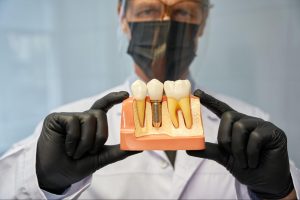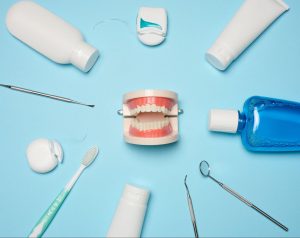Dental implants are an increasingly popular choice for replacing missing teeth, offering a permanent solution that improves functionality and aesthetics. While the cost of implant dentistry can be considerable, assessing whether the investment aligns with long-term benefits such as durability, comfort, and overall oral health is essential. Understanding the factors influencing pricing and the potential for lasting value and comparing them with other alternatives can help determine if dental implants are worthwhile.
What Are Dental Implants?
Dental implants offer a modern and effective solution for restoring missing or damaged teeth. They provide a stable base for replacement teeth that look and feel natural. Their durability and seamless integration with the bone make them a preferred choice for improved functionality, comfort, and aesthetics.
Components of a Dental Implant
Dental implants consist of three primary components: the implant post, the abutment, and the crown. Each plays a crucial role in ensuring the implant’s durability, stability, and aesthetics. Together, they offer a reliable and long-lasting replacement for lost teeth, providing functional and cosmetic benefits:
The Implant Post
The implant post is a titanium screw that is surgically placed into the jawbone, acting as the root for the new tooth. Made from titanium, the post fuses with the bone in osseointegration, ensuring a stable and strong foundation. This fusion helps the implant stay secure, preventing it from shifting or loosening over time.
The Abutment
The abutment is a small connector that sits on top of the implant post. It serves as a link between the implant post and the crown, allowing for a secure attachment of the visible part of the implant. The abutment is custom-made to fit each patient’s implant post, ensuring a stable connection.
The Crown
The crown is the visible part of the implant that resembles a natural tooth. It is custom-designed to match the size, shape, and color of surrounding teeth and is made from durable materials such as porcelain or zirconia. It provides a seamless, natural appearance and completes the restoration process.
Why Dental Implants Are Worth the Investment
Dental implants offer a range of benefits, making them a preferred choice for many people seeking tooth replacements. These benefits go beyond aesthetics, improving both oral health and daily functionality. They help restore confidence and quality of life by providing a permanent solution for missing teeth. Below are some of the key advantages that dental implants offer:
Durability and Longevity
Dental implants are known for their durability and can last a lifetime with proper care. Unlike other tooth replacement options, such as dentures or bridges, which need to be replaced or adjusted over time, implants remain stable and functional. This longevity makes implants a cost-effective choice in the long run, reducing the need for frequent replacements or repairs.
Improved Oral Health
Implants help prevent bone loss that typically occurs when teeth are missing. By stimulating the jawbone, they preserve its density and structure, preventing the deterioration that often leads to further tooth loss. This protection supports oral health and can help avoid additional complications, such as changes to the facial structure or shifting of nearby teeth.
Enhanced Comfort and Functionality
Dental implants function like natural teeth, providing a secure, comfortable solution for eating, speaking, and smiling. Unlike removable dentures, which can slip or cause discomfort, implants are fixed in place, offering improved stability. With implants, individuals can enjoy their favorite foods and speak confidently without worrying about shifting teeth or irritation.
Confidence Boost
A natural-looking smile can significantly improve self-esteem and social interactions. With dental implants, you no longer have to worry about the discomfort or awkwardness of removable dentures. Implants’ stability and aesthetic appeal help restore confidence, allowing you to smile freely and easily engage in social situations.
Breaking Down the Cost of Dental Implants
Several factors determine the final price of dental implants. These include the number of implants required, the type of restoration chosen, and the materials used. Other key factors, such as the dentist’s expertise, geographic location, and the need for preliminary procedures, can all impact the overall cost of the procedure.
Number of Implants Needed
Single implants generally cost less than multiple implants or full-mouth restorations. However, the more implants needed, the higher the cost, as each additional implant adds to the complexity and materials required for the procedure. A full-mouth restoration, which may involve multiple implants to support a full set of teeth, can significantly increase the overall expense.
Type of Restoration
The type of restoration chosen will also affect the price of the dental implants. A single crown is usually less expensive than a bridge or implant-supported denture, as the latter involves multiple components and more complex work. Full-arch or multiple-tooth restorations generally carry higher costs due to the materials and labor involved.
Material Used
The materials used for the implant post and the restoration will influence the price. Zirconia crowns, for example, are high-quality materials that can offer enhanced aesthetics and durability but come at a higher cost than traditional porcelain. High-grade titanium posts and advanced restoration materials contribute to a more expensive final cost.
Location and Expertise
The dental practice’s geographic location and the implant dentist’s experience can significantly affect pricing. Dental practices in metropolitan areas or regions with higher living costs may charge more. Additionally, highly skilled and experienced specialists may charge a premium, but their expertise can ensure better results and long-term success.
Preliminary Procedures
Some patients may need preliminary procedures to prepare the jaw before placing a dental implant, such as bone grafts, sinus lifts, or extractions. These treatments are often necessary if the patient’s jawbone cannot support the implant. Each additional procedure adds to the overall cost, with bone grafts costing anywhere from $200 to $3,000 per site.
Technology and Techniques
Advanced technology and techniques used during the implant procedure can also increase the price. Tools like 3D imaging, computer-assisted planning, and guided surgery can improve precision and outcomes but often come with higher costs. While these technologies increase costs, they can also contribute to a more successful and efficient treatment process.
Average Cost Breakdown
The cost of dental implants varies based on individual needs and circumstances. On average, a single implant, which includes the post, abutment, and crown, typically costs between $3,000 and $5,000. For more extensive cases like full-mouth restorations, the cost can range from $20,000 to $50,000 or more, depending on the number of implants and the type of restoration used. Additional procedures, such as bone grafts, may add anywhere from $200 to $3,000 per site, depending on the complexity and extent of the required grafting.
Insurance and Financing Options for Dental Implants
One of the biggest concerns about dental implants is affordability. While dental insurance often covers a portion of the cost, it’s not always comprehensive, and many plans consider implants an elective procedure. However, understanding the insurance coverage and exploring available financing options can make the cost more manageable. By planning and evaluating these options, you can make dental implants a more accessible choice without compromising the quality of care.
Understanding Insurance Coverage
Dental insurance plans typically do not cover the full cost of dental implants, as they are often classified as elective procedures. However, some plans may cover a portion of the cost if implants are deemed medically necessary, such as in cases of severe tooth loss or after an injury. Dental insurance will generally help with the costs of preparatory procedures, like extractions, but not the implants themselves. Reviewing your specific insurance policy to understand what is covered and what out-of-pocket costs you can expect is important.
Financing Solutions
For patients who do not have full coverage or prefer not to pay the entire cost upfront, several financing options are available to help make dental implants more affordable. These options allow you to spread out the cost over time and manage payments in a way that fits your budget. Here are some common financing solutions for dental implants:
Payment Plans
Many dental offices offer in-house financing with monthly payment options. These plans allow patients to pay for their implants over time, making the procedure more affordable by breaking the total cost into manageable installments. Interest rates and terms vary by practice, so asking about options and understanding the terms before committing is essential.
Healthcare Credit Cards
Healthcare credit cards allow you to finance dental procedures with low or no interest for a set period. These cards are specifically for healthcare expenses, including dental implants, and offer flexible repayment plans. Some plans come with promotional periods with no interest, making them an attractive option for those who can pay off the balance within the time frame.
Dental Savings Plans
Dental savings plans, also known as dental discount plans, can help lower the overall cost of dental implants. For an annual membership fee, these plans offer discounts on dental procedures, including implants. While not insurance, these plans can provide significant savings and make procedures more affordable, especially if you don’t have dental insurance.
The Lasting Value of Dental Implants
While the upfront cost of dental implants can be significant, their long-term benefits often make them a worthy investment for many individuals. The combination of durability, improved oral health, enhanced comfort, and a confidence boost makes dental implants a reliable solution for those seeking to restore their smile and functionality. By considering the factors that influence the cost and weighing the long-term advantages, you can decide whether dental implants are the right choice for you. With the right planning and financing options, dental implants can have a lasting, positive impact on oral health and overall quality of life.
Discover more about how dental implants can transform your smile. Visit our Meader Family Dentistry blog today.






